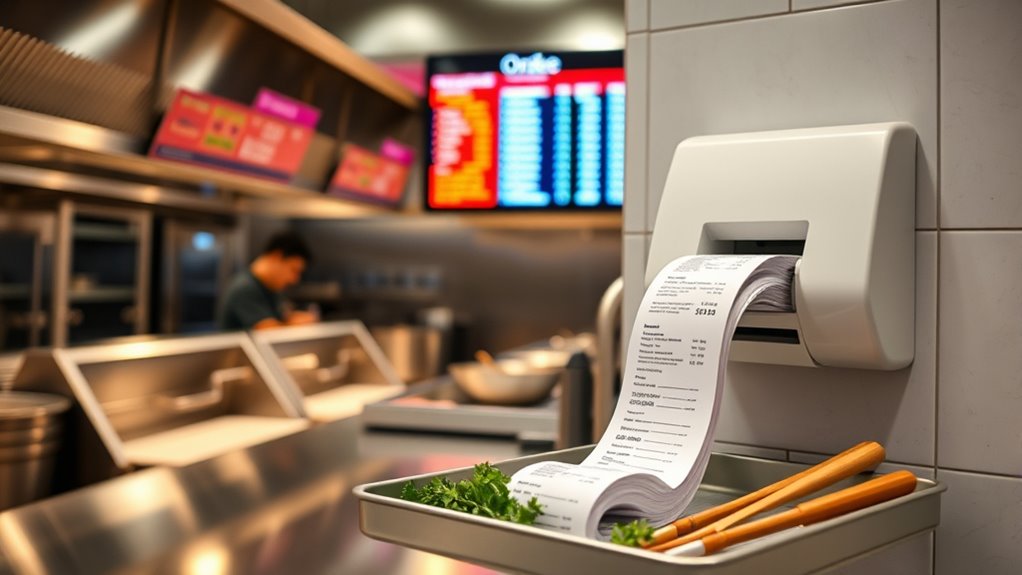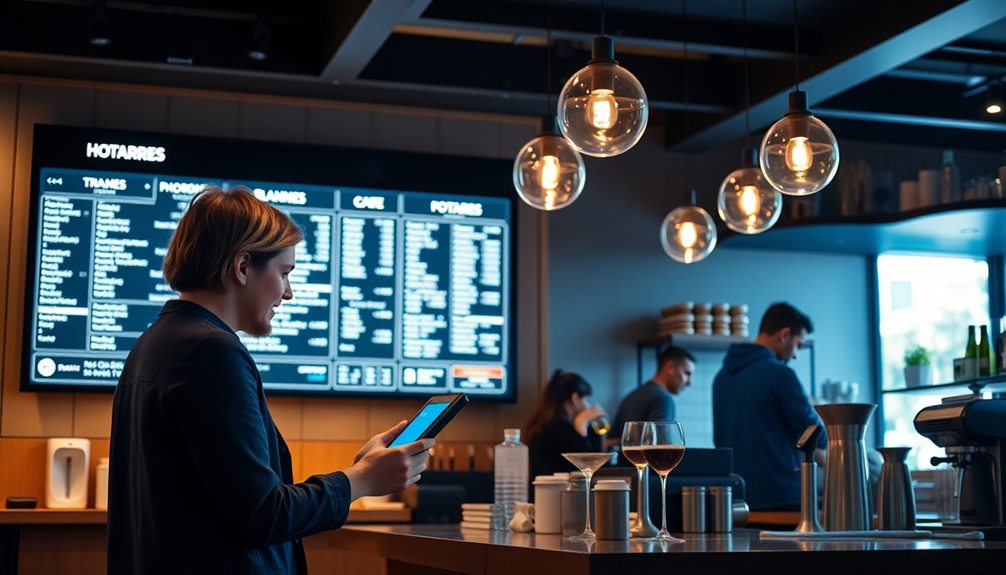Kitchen display systems (KDS) boost speed, accuracy, and efficiency by providing instant updates and visual cues, reducing errors common with printed tickets. While printed tickets are simple and cost less upfront, they can cause delays, misreads, and misplacement, slowing down your service. KDS may require a higher initial investment but save you money long-term through better organization and fewer mistakes. Explore how these systems transform your kitchen workflow and where technology is headed next for more insights.
Key Takeaways
- KDS provides real-time, instant order updates, reducing delays and miscommunication, unlike printed tickets which can be misplaced or delayed.
- Digital KDS enhances accuracy with visual cues and alerts, decreasing errors compared to handwritten or printed tickets.
- KDS requires higher initial investment but offers long-term savings through reduced paper costs and improved operational efficiency.
- Printed tickets are simple and low-cost but less flexible, often leading to clutter, misreads, and slower communication.
- Modern KDS systems integrate with POS and utilize AI, supporting advanced features like analytics, voice commands, and data security.
Overview of Kitchen Display Systems and Printed Tickets
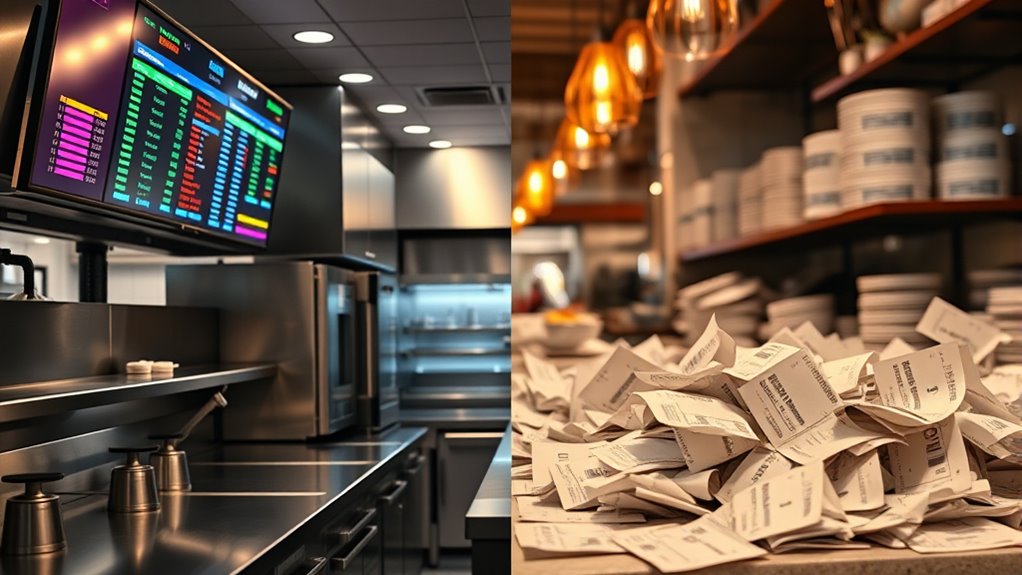
Kitchen display systems (KDS) and printed tickets are two common methods restaurants use to communicate orders to the kitchen. KDS replaces traditional paper tickets with digital screens that display orders instantly as they’re received. This reduces clutter and minimizes the risk of lost or misread tickets. The system updates in real-time, allowing kitchen staff to see new orders, modifications, or cancellations immediately. Printed tickets, on the other hand, involve physical slips of paper printed by a POS system. They are straightforward, easy to understand, and require no technology beyond the printer. While printed tickets are simple and familiar, they can create clutter and delays if not managed efficiently. Both methods serve the same purpose but differ remarkably in how they streamline communication and impact kitchen workflow.
Speed and Efficiency in Order Processing
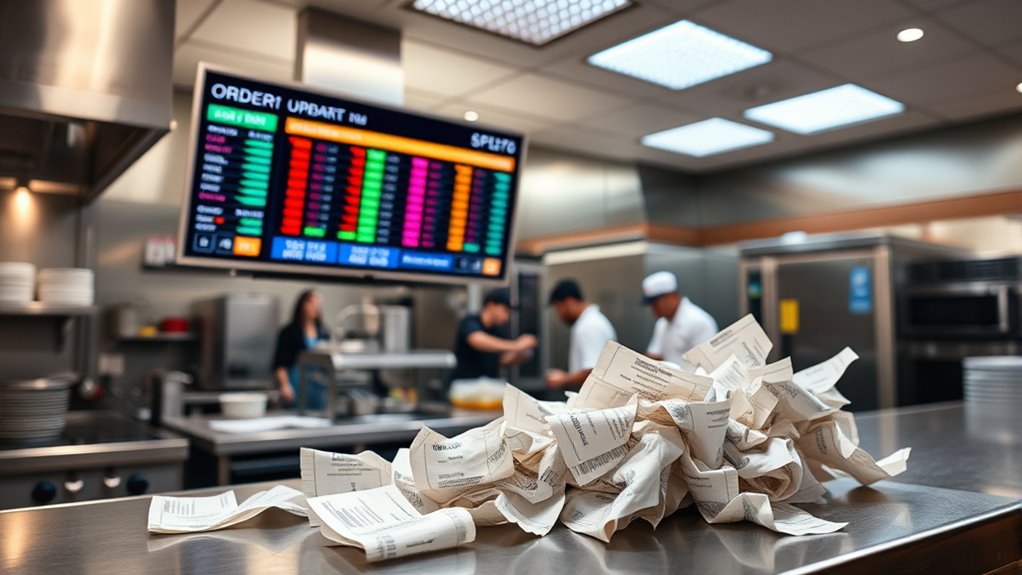
When it comes to processing orders quickly and efficiently, digital kitchen display systems often outperform printed tickets by providing instant updates and reducing delays. These systems streamline communication between servers and kitchen staff, ensuring orders are received immediately. Unlike printed tickets, which can be misplaced or delayed, display screens update in real-time, minimizing wait times and bottlenecks. Additionally, the use of kitchen display systems can improve overall workflow management in busy restaurant environments.
Accuracy and Error Reduction
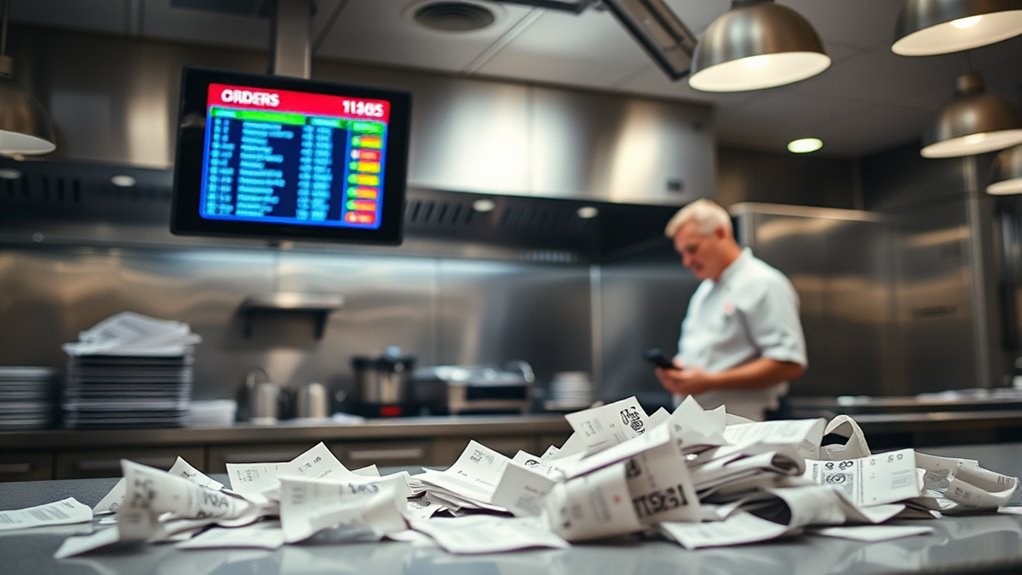
You can improve order accuracy with clearer tracking systems that reduce confusion. Error prevention features like automatic checks help catch mistakes before they reach the kitchen. This guarantees your orders are correct and customers leave satisfied.
Order Tracking Clarity
Order tracking accuracy plays a essential role in ensuring smooth kitchen operations and customer satisfaction. Clear tracking helps you quickly identify each dish’s status, reducing confusion during busy hours. Kitchen Display Systems (KDS) display orders in real-time, so staff easily follow updates and prioritize tasks. This minimizes missed or delayed orders, ensuring each plate reaches the customer promptly. Printed tickets, on the other hand, can be lost, smudged, or misread, leading to mistakes. With precise order tracking, you can swiftly address any discrepancies, avoid mix-ups, and maintain a steady workflow. Accurate visibility into each order’s progress boosts efficiency and confidence among your team, ultimately resulting in better service and happier customers. Clear order tracking keeps everyone on the same page, reducing errors and enhancing overall kitchen performance. Additionally, integrating Bluetooth connectivity allows for seamless wireless communication between devices, further improving order accuracy and response times.
Error Prevention Measures
Implementing effective error prevention measures is essential for reducing mistakes and maintaining accuracy in kitchen operations. With kitchen display systems (KDS), you minimize handwritten errors by automatically transmitting orders, reducing miscommunications. KDS also offers visual cues and clear instructions, helping staff quickly verify orders and catch mistakes before they reach the customer. Printed tickets, on the other hand, are prone to misreading or misplacing, increasing the risk of errors. To improve accuracy, guarantee your system includes features like order confirmation screens or alerts for discrepancies. Training staff to double-check orders and encouraging communication further reduces mistakes. Additionally, incorporating color-coding or visual indicators can help staff easily identify and verify order details at a glance. Ultimately, combining technology with proper procedures creates a robust error prevention strategy that enhances overall efficiency and customer satisfaction.
Cost Implications and Investment Needs
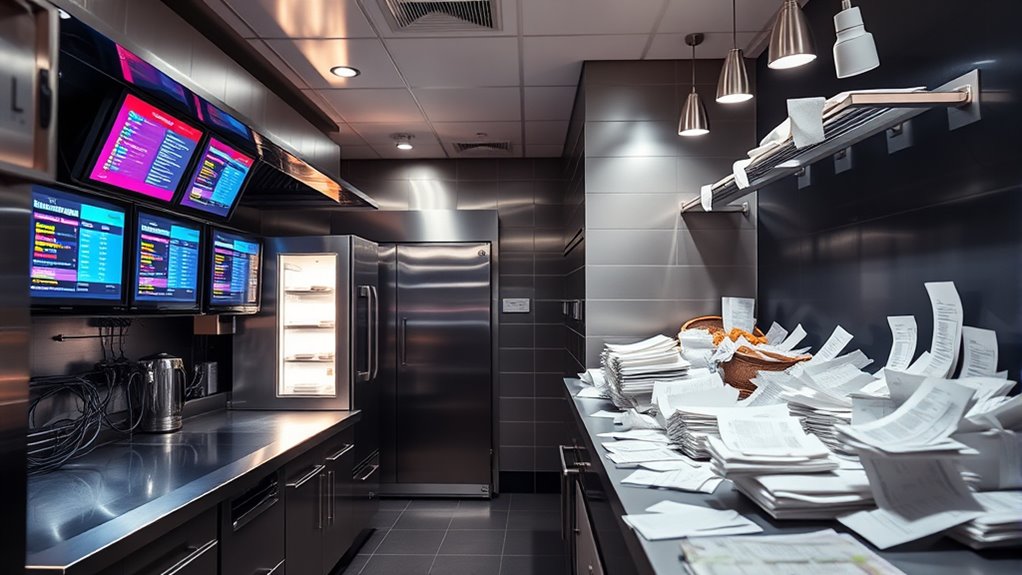
While kitchen display systems (KDS) often require a higher upfront investment compared to printed tickets, their long-term cost benefits can outweigh initial expenses. Your initial costs include hardware, software licenses, and installation, which can be substantial. However, these expenses are offset by savings over time through reduced paper costs, minimized order errors, and improved efficiency. Additionally, integrating high-quality displays with color accuracy can further enhance order visibility and reduce mistakes. Consider these key points: 1. Higher initial investment for hardware and setup. 2. Lower ongoing costs due to reduced paper and ink expenses. 3. Increased accuracy and efficiency that can lead to faster order fulfillment and higher sales. Ultimately, while the upfront costs are higher, the savings and operational improvements can make KDS a cost-effective choice in the long run.
Impact on Kitchen Workflow and Staff Communication

Kitchen display systems provide real-time order updates, helping your team stay synchronized and responsive. This reduces errors and guarantees orders are prepared accurately, improving overall efficiency. With better staff coordination, your kitchen can operate more smoothly and serve customers faster. Implementing these systems can also streamline communication, leading to a more efficient workflow and enhanced customer satisfaction.
Real-time Order Updates
Real-time order updates considerably enhance kitchen workflow by providing staff with instant notifications of new or modified orders, reducing delays and confusion. This immediacy keeps everyone on the same page and speeds up service. Imagine these benefits:
- Orders appear instantly on screens, eliminating the need to check printers or listen for calls.
- Changes to orders update automatically, ensuring accuracy without manual re-entry.
- Staff can prioritize tasks based on current orders, avoiding bottlenecks and improving efficiency.
- Incorporating Glycolic Acid in skincare routines can further improve skin texture and overall appearance, supporting a healthy look for staff working long hours.
With real-time updates, your kitchen can respond quickly to changes, coordinate better among team members, and keep the flow smooth. This seamless communication minimizes mistakes and helps maintain a steady pace, ultimately improving guest satisfaction and operational efficiency.
Error Reduction Potential
Implementing Kitchen Display Systems substantially reduces errors caused by miscommunication and manual entry, enhancing overall workflow and staff coordination. With digital screens, orders are transmitted instantly and accurately, eliminating handwriting misinterpretations or forgotten tickets. This real-time transfer minimizes the risk of incorrect dishes or missing items, leading to fewer customer complaints. Kitchen staff no longer rely on verbal instructions or paper tickets, which can be lost or misread under busy conditions. The clear, organized display helps staff prioritize tasks efficiently, reducing mistakes caused by confusion or clutter. Additionally, maintaining regular system updates ensures optimal performance and security. Overall, this system streamlines communication, promotes consistency, and decreases the likelihood of costly errors, ensuring smoother kitchen operations and improved customer satisfaction.
Staff Coordination Efficiency
By streamlining communication, Kitchen Display Systems considerably improve staff coordination and overall workflow. With clear, real-time updates, your team can work more efficiently and avoid confusion. You’ll notice:
- Orders automatically appear on screens, reducing the time spent relaying tickets.
- Staff can quickly see priority items, helping with timely preparation.
- Communication gaps decrease, minimizing missed or incorrect orders.
- Incorporating mental clarity techniques can further enhance focus and reduce workplace stress.
This setup minimizes the need for verbal exchanges and paper checks, keeping everyone on the same page. Staff can focus more on cooking rather than managing tickets or clarifying orders. As a result, your kitchen runs smoother, and service becomes faster. Improved coordination ensures fewer mistakes and a more synchronized team effort, elevating the overall dining experience.
Flexibility and Customization Options
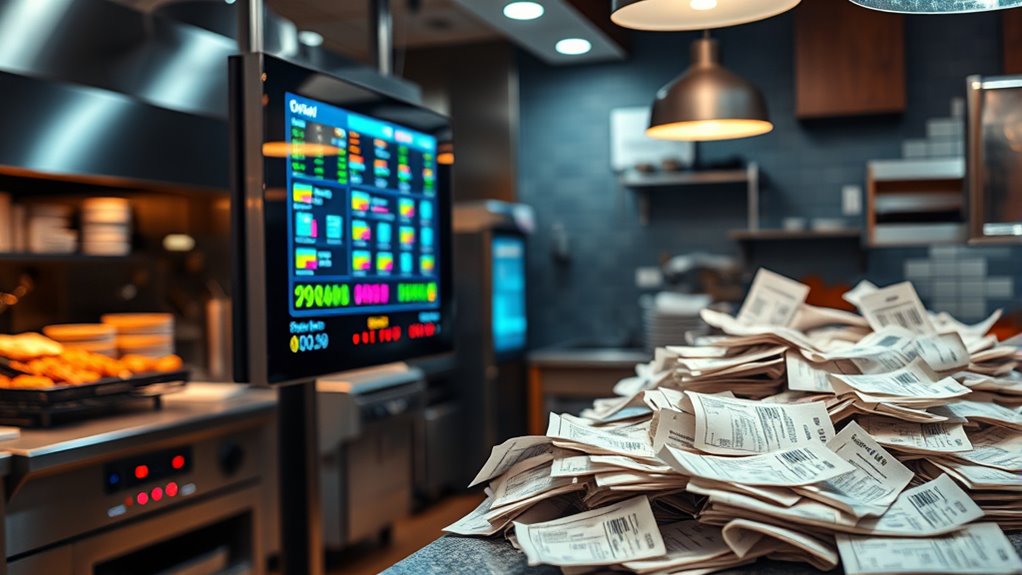
When it comes to flexibility and customization, kitchen display systems (KDS) offer significant advantages over printed tickets. You can easily modify order layouts, prioritize dishes, and set alerts based on specific needs. Unlike printed tickets, KDS allows real-time updates, reducing errors and improving workflow. You can customize display settings for different stations, making it easier to manage complex orders. Here’s a quick comparison:
| Feature | Printed Tickets | Kitchen Display Systems (KDS) |
|---|---|---|
| Order Modifications | Manual, time-consuming | Instant, easy to update |
| Custom Alerts | Not available | Customizable for prep times |
| Display Personalization | Limited | Fully customizable by station |
| Layout Flexibility | Fixed, paper format | Dynamic, digital interfaces |
This flexibility helps tailor your kitchen operations to your specific workflow. Additionally, KDS can enhance overall kitchen efficiency by streamlining communication and reducing waste.
Future Trends and Technological Advancements
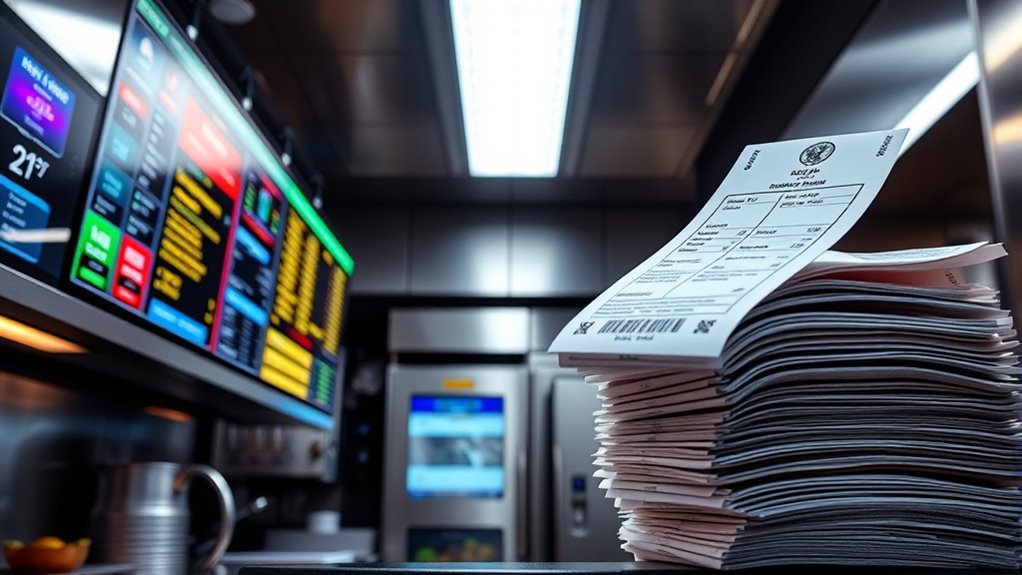
Advancements in kitchen display systems are shaping the future of restaurant operations, making workflows more efficient and responsive. You’ll see smarter integrations with POS systems, enabling real-time updates and reducing errors. Voice recognition technology may soon allow staff to communicate orders hands-free, speeding up kitchen processes. Additionally, AI-driven analytics will help you monitor performance, predict busy periods, and optimize staffing. Incorporating AI security technologies ensures data protection and reduces vulnerabilities within your systems. These innovations will help you enhance accuracy, speed, and customer satisfaction. As technology evolves, kitchen display systems will become even smarter, ensuring your restaurant stays competitive and efficient in a rapidly changing industry.
Frequently Asked Questions
How Do Kitchen Display Systems Integrate With Existing POS Software?
You want to know how kitchen display systems integrate with your POS software. Typically, they connect via APIs or direct software plugins, allowing seamless communication. Once integrated, orders automatically transfer from your POS to the display system, reducing errors and speeding up service. You may need to update or configure your software settings, but most systems offer straightforward integration, enhancing your kitchen’s efficiency without disrupting existing operations.
What Are the Maintenance Requirements for Digital Display Systems?
Imagine your kitchen illuminated by vibrant screens showing orders in real-time, replacing cluttered papers. To keep this digital hub running smoothly, you’ll need to perform regular software updates and monitor hardware for any glitches. Clean the screens gently to prevent dust buildup, and make certain your network connection stays strong for seamless communication. With consistent care, your digital display system remains reliable, enhancing your kitchen’s efficiency and reducing order errors.
How Do Printed Tickets Impact Environmental Sustainability?
Printed tickets considerably impact environmental sustainability because they use paper, contributing to deforestation and waste. When you rely on printed tickets, you increase paper consumption, which leads to higher energy use and pollution from manufacturing and disposal. By reducing or eliminating printed tickets, you help conserve resources, lower waste, and minimize your carbon footprint. Switching to digital systems is a practical way to promote eco-friendly practices in your operations.
Can Kitchen Display Systems Operate Offline During Network Outages?
During network outages, you might wonder if kitchen display systems (KDS) can still operate. Many modern KDS are designed with offline capabilities, so they continue functioning without an internet connection. You’ll still receive orders, update statuses, and manage the kitchen efficiently. Once the network is restored, the system syncs seamlessly with the server, ensuring no data is lost. This reliability helps keep your kitchen running smoothly even during connectivity issues.
What Training Is Necessary for Staff to Effectively Use New Systems?
Think of your staff as the gears in a well-oiled machine; their training keeps everything running smoothly. To guarantee they use new systems effectively, you’ll need to provide hands-on training sessions, clear instructions, and ongoing support. Encourage questions and practice to build confidence. Just like tuning a musical instrument, proper training aligns everyone’s skills, allowing your team to operate new technology seamlessly and improve overall efficiency.
Conclusion
Ultimately, choosing between kitchen display systems and printed tickets shapes your kitchen’s future. While printed tickets are familiar, digital systems enable speed, accuracy, and seamless communication—like a well-orchestrated symphony. Don’t let tradition hold you back from innovation. Embrace the technology that elevates your kitchen’s efficiency and reduces errors. After all, in a world that’s constantly evolving, isn’t the goal to stay ahead? Choose wisely—your kitchen’s success depends on it.
